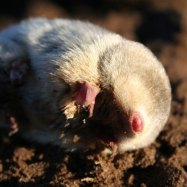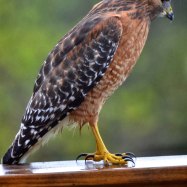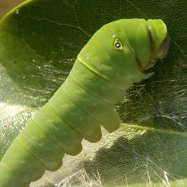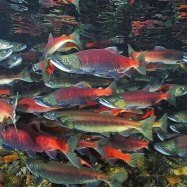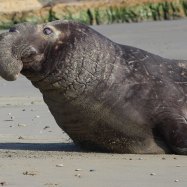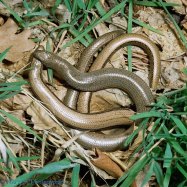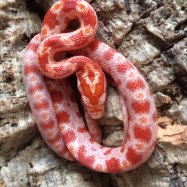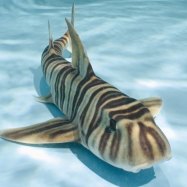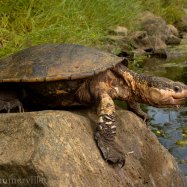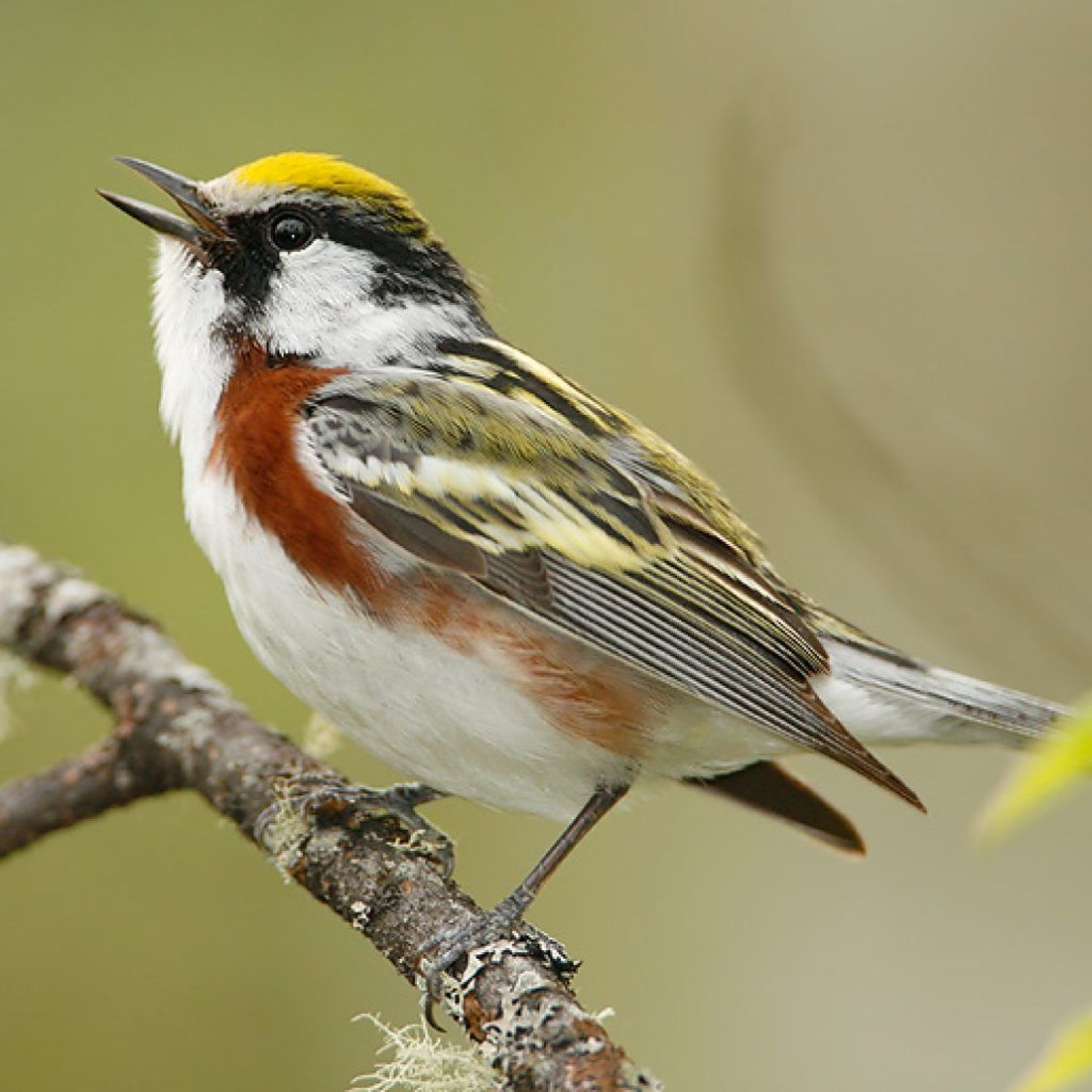
Chestnut Sided Warbler
12 - 14 cm
The Chestnut Sided Warbler is a small but stunning bird found in Eastern North America. With its slender body and long tail, it belongs to the Parulidae family. It measures between 12-14 cm in length and is a favorite among birdwatchers. Keep your eyes peeled for this colorful bird next time you're out exploring nature! #birdwatching #NorthAmerica #warbler
Animal Details Summary:
Common Name: Chestnut-sided Warbler
Kingdom: Animalia
Habitat: Deciduous forests, mixed forests, wooded swamps
The Vibrant Chestnut Sided Warbler: A Jewel of Eastern North America
Imagine yourself walking through a forest in the eastern part of North America, surrounded by tall trees and the musical chirping of birds. Suddenly, a flash of bright yellow catches your eye, and you witness a small bird hopping from one branch to another. With a closer look, you realize you are observing a Chestnut Sided Warbler, a stunning bird known for its vibrant colors and lively personality.The Chestnut Sided Warbler, also known by its scientific name Setophaga pensylvanica, is a member of the Parulidae family, commonly referred to as the New World Warblers Chestnut Sided Warbler. This small, songbird is found in the deciduous and mixed forests of eastern North America, making it a delight for both birdwatchers and nature enthusiasts.
The Anatomy and Physical Features of a Chestnut Sided Warbler
The Chestnut Sided Warbler is a small bird, measuring between 12 to 14 cm in length, with a relatively long tail and a slender body structure. Their wingspan can reach up to 19 cm, making them agile flyers. Just like most passerines, the Chestnut Sided Warbler has four toes, three of which face forward and one that faces backward, aiding them in perching and maneuvering through branches.The most distinctive feature of this bird is its bright yellow crown and chestnut-colored flanks, giving it a striking appearance. The upperparts of the Chestnut Sided Warbler are a smooth olive-green color, providing excellent camouflage in their natural habitat. On the other hand, their underparts are white, making them easily identifiable when seen from below.
One interesting fact about this bird is that their feathers change colors as they mature. Juvenile Chestnut Sided Warblers have a duller appearance, with a greenish-yellow crown and less vibrant chestnut flanks Chinese Shar Pei. However, as they grow, their feathers become brighter, signaling their readiness for mating.
The vibrant colors of the Chestnut Sided Warbler not only make them a treat for the eyes, but they also serve a more significant purpose – communication. The bright yellow crown of the male warbler is used to attract potential mates, while the distinct colors help differentiate between the males and females of the species.
The Habitat and Distribution of Chestnut Sided Warblers
The Chestnut Sided Warbler is native to North America, with its range extending from eastern Canada, through the United States, and down to Mexico. They can be found in wooded areas, including deciduous forests, mixed forests, and wooded swamps.During their breeding season, which spans from May to July, these birds inhabit the northern and eastern parts of their range, from Alberta and Manitoba in Canada down to North Carolina in the U.S. As the temperature drops, they migrate to the southern parts of their range, Mexico and Central America, to spend the winter months.
Chestnut Sided Warblers are known for their elusive nature, making it challenging to spot them. However, their vocalizations, a series of high, thin notes, make them easier to locate. Males are particularly vocal, singing their distinct songs from dawn to dusk to attract potential mates and mark their territory.
The Diet and Feeding Habits of Chestnut Sided Warblers
Chestnut Sided Warblers, like most birds, are primarily insectivorous, feeding on insects and spiders found in their natural habitat. These small birds are highly active, constantly foraging and hopping from branch to branch in search of prey.Their slender, pointed beaks are perfectly adapted for catching insects, such as caterpillars, beetles, and flies. These warblers also consume spiders, which provide essential nutrients for their growth and survival. They do not have a specific feeding pattern and are known for taking advantage of various opportunities to obtain food.
The Role of Chestnut Sided Warblers in Maintaining Ecological Balance
As insectivorous birds, the Chestnut Sided Warblers play a vital role in maintaining the ecological balance of their habitat. These birds are efficient predators, and their diet mainly consists of caterpillars and other insect larvae. By consuming these pests, warblers help limit the damage they cause to vegetation, ultimately aiding in plant growth and regeneration.Furthermore, these small birds also serve as food for larger predators, such as hawks and owls, who play a crucial role in controlling the populations of other animals. Therefore, the presence of Chestnut Sided Warblers in an ecosystem helps maintain a healthy balance between predator and prey populations.
The Threats and Conservation Efforts for Chestnut Sided Warblers
Despite their vibrant colors and essential role in the ecosystem, Chestnut Sided Warblers face several threats to their survival. One of the most significant threats is habitat destruction, as their preferred wooded habitats are continuously being cleared for human development.Another threat comes from predators, such as cats and snakes, who prey on the eggs and young of these birds. Climate change also poses a threat, as it affects their breeding and migration patterns, ultimately leading to population decline.
Fortunately, several conservation efforts are in place to protect these small birds from further decline. Organizations such as the National Audubon Society and the Cornell Lab of Ornithology work towards preserving and restoring the habitat of Chestnut Sided Warblers through education, research, and conservation efforts.
Individual actions can also make a difference in preserving these birds. For example, providing food, water, and shelter in your backyard can create a habitat for not only warblers but other birds as well. Planting native trees and shrubs also adds to the vegetation that these birds rely on for survival.
A Beautiful Harmony in Nature
The Chestnut Sided Warbler, with its striking colors and melodious songs, is a small but essential part of the intricate web of life in eastern North America. As we continue to witness the devastating effects of human activities on our natural world, the importance of preserving and protecting species like the Chestnut Sided Warbler becomes more evident.These small birds remind us of the beauty and harmony found in nature, and the role we must play in preserving it for future generations. So, the next time you take a walk in the forest, keep an eye out for the vibrant and elusive Chestnut Sided Warbler, and remember, we all have a part to play in protecting these jewels of eastern North America.

Chestnut Sided Warbler
Animal Details Chestnut Sided Warbler - Scientific Name: Setophaga pensylvanica
- Category: Animals C
- Scientific Name: Setophaga pensylvanica
- Common Name: Chestnut-sided Warbler
- Kingdom: Animalia
- Phylum: Chordata
- Class: Aves
- Order: Passeriformes
- Family: Parulidae
- Habitat: Deciduous forests, mixed forests, wooded swamps
- Feeding Method: Primarily insectivorous, feeding on insects and spiders
- Geographical Distribution: North America
- Country of Origin: United States, Canada
- Location: Eastern North America
- Animal Coloration: Bright yellow crown and chestnut-colored flanks with white underparts
- Body Shape: Small bird with a slender body and a relatively long tail
- Length: 12 - 14 cm
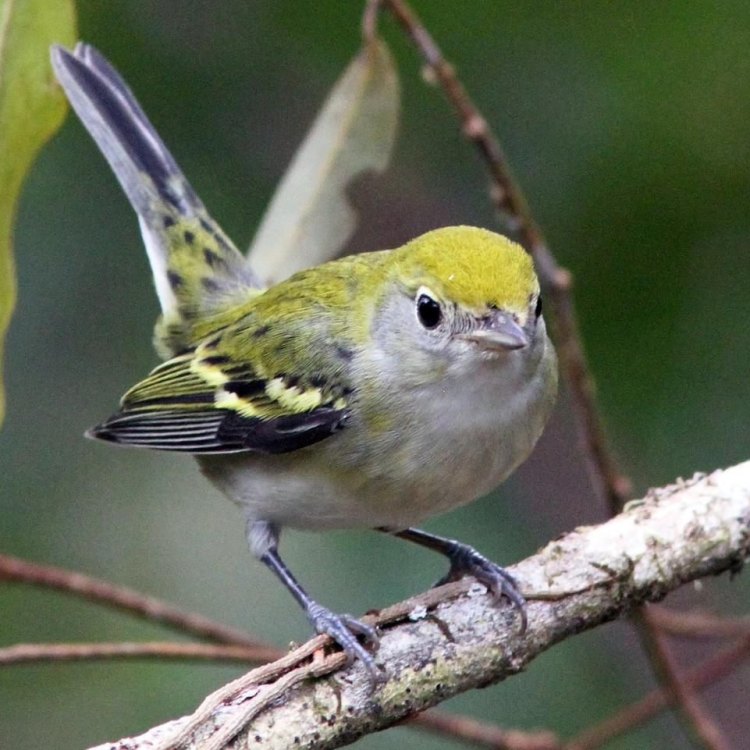
Chestnut-sided Warbler
- Adult Size: Small
- Average Lifespan: 3-6 years
- Reproduction: Sexual reproduction
- Reproductive Behavior: Monogamous, males attract females through song and courtship displays
- Sound or Call: Distinctive song made up of high-pitched notes
- Migration Pattern: Long-distance migratory bird, winters in Central America and breeds in North America
- Social Groups: Often found in mixed-species foraging flocks during migration
- Behavior: Active and agile forager, known for its aerial acrobatics
- Threats: Habitat loss, climate change, pesticide use
- Conservation Status: Least Concern
- Impact on Ecosystem: Helps control insect populations
- Human Use: Birdwatching, ecotourism
- Distinctive Features: Bright chestnut flanks and yellow crown, distinctive song
- Interesting Facts: Chestnut-sided Warblers are one of the first neo-tropical migrants to arrive in the spring and one of the last to leave in the fall
- Predator: Snakes, birds of prey, domestic cats
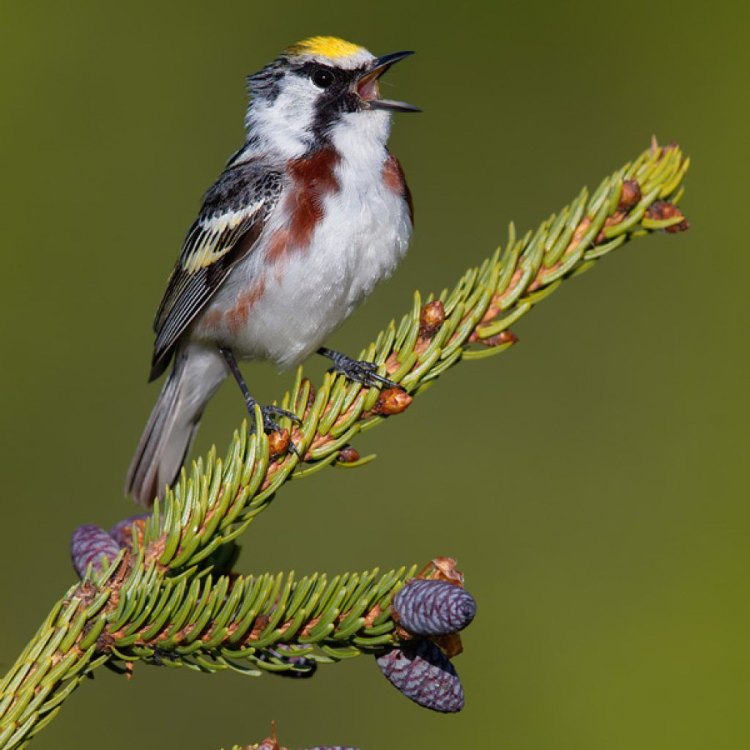
Setophaga pensylvanica
The Colorful Chestnut Sided Warbler: A Small But Mighty Migratory Bird
In a world filled with over 10,000 species of birds, the Chestnut Sided Warbler stands out with its striking appearance and unique behaviors. This small bird may be petite in size, but it is mighty and plays a crucial role in its ecosystem.The Chestnut Sided Warbler (Setophaga pensylvanica) is a North American migratory songbird belonging to the wood-warbler family. It is known for its distinctive appearance, vocalizations, and migration patterns PeaceOfAnimals.Com.
Adult Chestnut Sided Warblers are relatively small, measuring between 4.7-5.8 inches in length and weighing only around 0.3-0.5 ounces. Despite their small size, these birds have an average lifespan of 3-6 years, with the oldest recorded individual living up to 11 years.
Reproduction in Chestnut Sided Warblers occurs through sexual reproduction, with males attracting females through their unique song and courtship displays. During the breeding season, male warblers establish territories and showcase their singing abilities to attract a mate.
The distinctive song of the Chestnut Sided Warbler is made up of high-pitched notes and is often described as a sweet series of "pleased pleased pleased to meetcha Clothes Moth." This song can be heard throughout their breeding range, attracting both females and other males for territorial disputes.
But what makes this little bird stand out is its bright chestnut flanks and yellow crown, earning it the nickname "butter butt." These colors are most evident in males, and they play a vital role in attracting females during courtship. The brighter the colors, the more desirable the male is to potential mates.
During the breeding season, Chestnut Sided Warblers can be found in deciduous forests and shrubby habitats in eastern North America. Come fall, these birds embark on a long-distance migration, traveling to Central America where they spend the winter months before returning to North America for the breeding season.
The migration of Chestnut Sided Warblers is considered remarkable, as these birds can travel up to 2000 miles each way, crossing the Gulf of Mexico. They are one of the first neo-tropical migrants to arrive in the spring and one of the last to leave in the fall. This feat is even more impressive considering their small size and reliance on stopovers for food and rest during their journey.
During migration, Chestnut Sided Warblers can be found in mixed-species foraging flocks, traveling alongside other migratory species and local resident birds such as chickadees and titmice. This behavior provides the warblers with added safety against predators and increases their chances of finding food during the long journey.
When it comes to behavior, Chestnut Sided Warblers are active and agile foragers, known for their aerial acrobatics. These birds feed primarily on insects, which they capture in mid-air or forage for on twigs and leaves. They are also known to occasionally feed on fruits, nectar, and small seeds for added nutrition.
The Chestnut Sided Warbler's diet and foraging behavior make them essential players in their ecosystem. As insect-eaters, they help control the population of insects such as caterpillars, which can cause damage to forests and agriculture.
But despite their crucial role in the ecosystem, Chestnut Sided Warblers face numerous threats that impact their survival. Habitat loss due to deforestation, urbanization, and agriculture development is a significant threat to their breeding and wintering grounds. Climate change also poses a threat, causing changes in temperature, water availability, and food sources.
Pesticide use is another major concern for Chestnut Sided Warblers, as these chemicals can harm both the birds and the insects they rely on for food. This impact is seen not only in their breeding and wintering grounds but also during their migration journey, as they can be exposed to pesticides while resting in agricultural areas.
However, despite these threats, the Chestnut Sided Warbler's conservation status is currently listed as "Least Concern" by the International Union for Conservation of Nature (IUCN). While their populations have declined in some areas, overall, they are still relatively abundant and widespread.
One of the reasons for this is the increased awareness and conservation efforts aimed towards protecting these birds and their habitats. The Chestnut Sided Warbler is a popular species for birdwatching, drawing in thousands of ecotourists every year. This interest has led to the establishment of protected areas and conservation programs to safeguard their breeding and wintering grounds.
Aside from human observation, Chestnut Sided Warblers also face natural predators such as snakes, birds of prey, and domestic cats. Cats, especially, pose a significant threat to these birds, as they are known to hunt for small bird species. Pet owners must keep their cats indoors, especially during the breeding season, to prevent predation of migratory birds like the Chestnut Sided Warbler.
In conclusion, the Chestnut Sided Warbler may be small in size, but they play a significant role in their ecosystem. With their striking appearance and distinctive behaviors, these birds have captured the interest of birdwatchers and scientists alike. But as with many other migratory species, they face threats that can impact their survival. By raising awareness and taking conservation actions, we can help protect these colorful birds and ensure that their unique features and behaviors continue to grace our skies for generations to come.
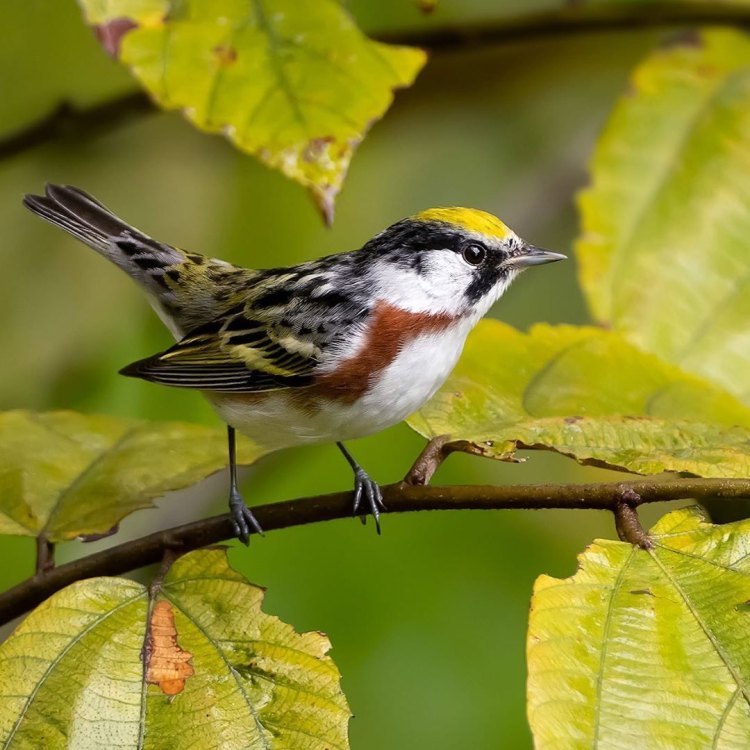
The Vibrant Chestnut Sided Warbler: A Jewel of Eastern North America
Disclaimer: The content provided is for informational purposes only. We cannot guarantee the accuracy of the information on this page 100%. All information provided here may change without prior notice.


